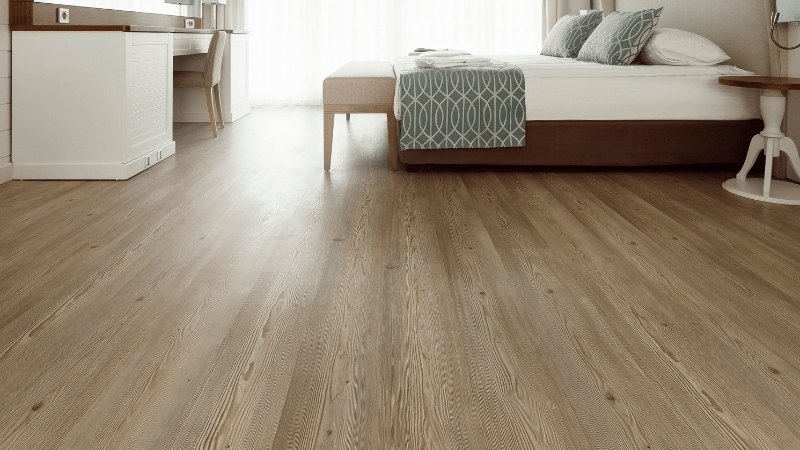Picture this: you’re walking barefoot across a floor that feels smooth and inviting, but what’s beneath the surface could be affecting your health more than you realize. Flooring is a crucial component of any home, influencing not only the aesthetic appeal but also the indoor air quality and overall comfort. For those with allergies or sensitivities, selecting the right flooring material can make a significant difference. Let’s dive into how different flooring options impact indoor air quality and sensitivities, and how you can make choices that support a healthier, allergy-friendly home.
The Impact of Flooring on Indoor Air Quality and Sensitivities
Flooring materials play a significant role in the quality of indoor air and can either contribute to or alleviate allergy symptoms. Here’s how various flooring options can affect your home environment:
Dust and Allergens
Some flooring types can trap dust, pollen and other allergens, which can then be stirred up into the air. Carpets, for example, can harbor dust mites, pet dander and mold if not regularly cleaned. Carpets can also off-gas Volatile Organic Compounds (VOCs) and formaldehyde. On the other hand, hard flooring surfaces like tile or wood are easier to clean but may require more attention to detail to avoid buildup in grout lines or under furniture.
Off-Gassing
Many flooring materials, particularly synthetic ones, can off-gas volatile organic compounds (VOCs) that contribute to indoor air pollution. VOCs are chemicals that evaporate into the air from certain products and can cause respiratory issues or other health concerns. Choosing low-VOC or no-VOC flooring options can reduce the impact on indoor air quality.
Ease of Cleaning
Flooring that is easy to clean helps maintain a healthier environment by reducing the buildup of dust, allergens, and bacteria. Materials that can be quickly swept, vacuumed or wiped down contribute to a cleaner and more hygienic living space.
Healthier Flooring Options
For individuals with allergies, Multiple Chemical Sensitivities (MCS) or just individuals who are looking for healthier options, choosing the right type of flooring is crucial to minimizing exposure to chemicals that could trigger symptoms. The best flooring options are those that are free from volatile organic compounds (VOCs), formaldehyde, phthalates and other toxic substances. Here are the best flooring options:
1. Solid Hardwood Flooring
- Why It’s Good: Solid hardwood is a natural material that, when finished with non-toxic, water-based sealants, offers an excellent healthier option. Hardwood floors are durable, easy to clean and do not trap allergens.
- What to Consider: Ensure that the hardwood is finished with low or zero-VOC stains and sealants. Avoid engineered wood, which can contain formaldehyde in the adhesives.
- Certifications: Look for FSC-certified wood to ensure sustainability and verify that the finishes are Greenguard Gold or FloorScore certified for low emissions.
2. Natural Cork Flooring
- Why It’s Good: Cork is a renewable resource that naturally resists mold, mildew, and pests. When untreated or sealed with non-toxic finishes, cork can be a good choice for those with MCS.
- What to Consider: Ensure the cork is free from synthetic finishes, adhesives, or backing materials that could off-gas. Also, check that it’s free from added formaldehyde.
- Certifications: Look for cork flooring with Greenguard or FloorScore certification to ensure low emissions.
3. Natural Linoleum
- Why It’s Good: Made from natural materials like linseed oil, cork dust, wood flour, and jute, natural linoleum (e.g., Marmoleum) is biodegradable and free from harmful chemicals. It’s also antimicrobial and easy to clean.
- What to Consider: Make sure the linoleum is installed using non-toxic adhesives or opt for a floating installation method to avoid adhesives altogether.
- Certifications: Greenguard Gold certification is ideal for ensuring low chemical emissions.
4. Ceramic or Porcelain Tile
- Why It’s Good: Tiles made from natural clay and fired at high temperatures are inert and do not off-gas. They are durable, water-resistant, and hypoallergenic.
- What to Consider: The key concern with tile flooring is the grout and adhesives. Choose low or zero-VOC grouts and thin-set mortars. Also, avoid tiles treated with chemical sealants or coatings.
- Certifications: Look for tiles that are Greenguard certified or ensure the installation materials meet low-VOC standards.
5. Bamboo Flooring
- Why It’s Good: Bamboo is a sustainable material that, when untreated or treated with non-toxic finishes, can be a good option for MCS sufferers. It’s durable and resistant to moisture.
- What to Consider: Some bamboo flooring is engineered using adhesives that can off-gas. Ensure you choose solid bamboo flooring that is formaldehyde-free and finished with non-toxic materials.
- Certifications: Look for FSC-certified bamboo and confirm that it’s free from harmful chemicals.
6. Concrete Flooring
- Why It’s Good: Concrete is a natural material that can be polished or sealed with non-toxic, low-VOC sealants. It’s durable, easy to maintain, and does not harbor allergens.
- What to Consider: Ensure that the sealants and any colorants used are low or zero-VOC. Concrete can be cold and hard, so consider adding non-toxic rugs or mats for comfort.
- Certifications: Use sealants and finishes that are Greenguard Gold or FloorScore certified.
7. Wool Carpet
- Why It’s Good: Wool is a natural, biodegradable material that does not require chemical treatments. When untreated or minimally treated, wool carpets can be a good option for those with MCS.
- What to Consider: Choose carpets that are 100% wool and free from synthetic dyes, flame retardants, and chemical mothproofing agents. Use natural fiber padding and non-toxic adhesives if needed.
- Certifications: Look for carpets with GOTS (Global Organic Textile Standard) or OEKO-TEX Standard 100 certifications.
8. Non-Toxic Carpet
- Why It’s Good: Some brands of rugs are made from other non-toxic material like 100% cotton. If the carpet is untreated, avoids adhesives and glues and is cleaned regular (vacuumed and/or steam cleaned with only hot water), they can be a another option for those with MCS.
- What to Consider: Choose carpets that are 100% free from synthetic dyes, flame retardants and chemical mothproofing agents. Use natural fiber padding and non-toxic adhesives if needed.
- Certifications: Look for carpets with GOTS (Global Organic Textile Standard) or OEKO-TEX Standard 100 certifications.
- Brand: An example of a carpet brand would be Hook and Loom.
General Tips for Healthier Choosing Flooring
- Avoid Synthetic Materials: Steer clear of vinyl, laminate and engineered wood products, as they often contain harmful chemicals like phthalates, formaldehyde, and other VOCs.
- Consider Installation Methods: Opt for floating floors (which do not require adhesives) whenever possible, or choose non-toxic, water-based adhesives if gluing is necessary.
- Check for Certifications: Always look for third-party certifications such as Greenguard Gold, FloorScore, FSC, GOTS, or OEKO-TEX to ensure the flooring meets strict environmental and health standards.
- Air Out New Flooring: If possible, allow new flooring materials to off-gas in a well-ventilated area before installation, or air out the room thoroughly after installation.
- Test for Sensitivity: If possible, bring a sample of the flooring into your home and test it in a small space to ensure it does not trigger any symptoms before committing to a larger installation.
- Green Building Supply: Green Building Supply is a retailer that specializes in environmentally friendly, non-toxic and sustainable building materials and home products. The company is dedicated to providing products that promote healthier indoor air quality, reduce environmental impact and support sustainable living practices.
Making the Right Choice for Your Home
When selecting flooring for an allergy-friendly home, consider the following tips:
- Evaluate Your Needs: Consider the specific needs of your household, including any allergy sufferers or individuals with sensitivities. Choose flooring that addresses these needs while complementing your lifestyle.
- Research Materials: Investigate the potential for off-gassing and choose materials with low VOCs or no VOCs. Opt for natural or low-impact options when possible.
- Regular Maintenance: Regardless of the flooring choice, regular cleaning and maintenance are crucial for maintaining a healthy environment. Establish a cleaning routine that fits your flooring type and household needs.
- Test Samples: Before making a final decision, obtain samples of the flooring options you’re considering. Test them in your home to see how they perform in terms of comfort, appearance, and maintenance.
Selecting the right flooring is essential for creating a healthier and allergy-friendly home and crucial for individuals with MCS, children or those with a compromised immune system. By understanding the impact of different materials on indoor air quality and sensitivities, you can make informed choices that contribute to a cleaner, more comfortable living environment. Natural materials like solid hardwood, cork, natural linoleum, ceramic tile and untreated wool offer the best options, especially when they are free from harmful chemicals and finishes. Always check for certifications and choose installation methods that minimize chemical exposure. Prioritizing low-VOC and easy-to-clean materials, along with regular maintenance, will help ensure your home remains a safe and inviting space for everyone.

